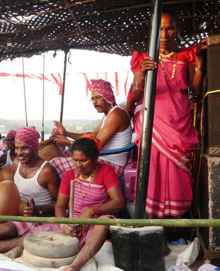Gauda and Kunbi
Gaudas are aboriginal people residing in the coastal Indian state of

Current social status
They are categorised as category I by Government of India along with Velip community. Original Gawda (गौड) community is now known as Gawada (गावडा) community.[2]
Modern organisations
Gaudas, Kunbis, Velip and another shepherding tribe called the Dhangar, have organised themselves into an aboriginal-focussed network, called The Gauda, Kunbi, Velip and Dhangar Federation (GAKUVED). Another Adivasi-rights resource center, called MAND, also works for their betterment.[3]
Shuddhi movement
In the late 1920s, prominent Goan Hindu Brahmins requested Vinayak Maharaj Masurkar, the prelate of a
References
- ^ Kerkar, Rajendra (22 January 2017). "Back to the cradle of tribal civilization". The Times of India.
- ^ Gazette of India Extra-ordinary part-II, section-I dated 08-01-2003 by Ministry of Law and Justice and Official Gazette of Government of Goa, Supplement Series – I, No.3 dated 17-04-2003.
- ISBN 9788190568289.
- ^ a b Kreinath, Hartung & Deschner 2004, p. 163
- ISBN 9788171690428.
- ISBN 9788174888655.
- ^ Godbole, Shriranga (2010). Sanskrutik Vartapatra (in Marathi). Pune: Sanskrutik Vartapatra. pp. 61–66.
- ^ Shirodkar & Mandal 1993, p. 23
- ^ Lusotopie 2001, p. 458
Works cited
- Kreinath, Jens; Hartung, Constance; Deschner, Annette (2004). Kreinath, Jens; Hartung, Constance; Deschner, Annette (eds.). The dynamics of changing rituals: the transformation of religious rituals within their social and cultural context. Peter Lang. ISBN 978-0-8204-6826-6.
- Lusophonies asiatiques, Asiatiques en lusophonies (in French). KARTHALA Editions. 1 January 2001. ISBN 978-2-84586-146-6.
- Shirodkar, Dr Prakashchandra; Mandal, H. K. (1993), Kumar Suresh Singh (ed.), Anthropological Survey of India, People of India, vol. 21: Goa, Popular Prakashan, ISBN 978-81-7154-760-9
Goa Gaud Samaj (GGS) -> https://goagaudsamaj.github.io/
Introduction: Nestled in the coastal state of Goa, India, the Gaudas and Kunbis represent the indigenous communities whose roots run deep in the fertile soil of Konkan. This detailed exploration unveils the layers of our cultural tapestry, showcasing a history that spans generations and embraces diverse influences.
Cultural Heritage: Our communities are proud torchbearers of folk Hinduism, cherishing ancient beliefs and practices that have withstood the test of time. From rituals to festivals, our cultural heritage serves as a living connection to the land we call home, reflecting a deep-seated reverence for tradition.
Spiritual Diversity: The narrative of the Gaudas and Kunbis unfolds against the backdrop of the Christianization of Goa, a historical chapter that introduced Portuguese missionaries and Catholicism to our communities. This intersection of faiths has resulted in a unique spiritual landscape where diverse beliefs coexist harmoniously. Today, one can witness the fusion of ancient Hindu rituals with the symbolism and traditions of Catholicism, creating a rich mosaic of spiritual diversity.
Christianization Influence: The influence of the Portuguese, particularly during the Christianization era, is woven into the fabric of our communities. Many embraced Catholicism, and this amalgamation of faiths has shaped our identity. It is a delicate dance between religious conversion and the steadfast preservation of our distinct cultural ethos.
Cultural Resilience: Resilience defines the spirit of the Gaudas and Kunbis. Despite external influences, our commitment to preserving our folk traditions and cultural practices remains unyielding. The rituals passed down through generations, the vibrant celebrations of festivals, and the daily routines are all manifestations of our resilience, echoing the voices of our ancestors through time.
Tapestry of Tradition and Modernity: In the 21st century, the Gaudas and Kunbis exemplify a harmonious blend of tradition and modernity. Our communities have seamlessly integrated ancient customs with contemporary living. Traditional practices find expression alongside the conveniences of the modern world, creating a dynamic cultural experience that reflects both our roots and our evolution.
